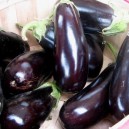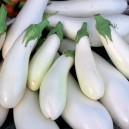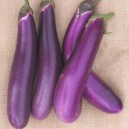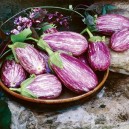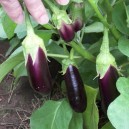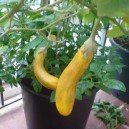
Welcome, Log in
Product Categories
-
Heirloom & OP Seed
- Cool Weather Crops
- Warm Weather Crops
- Beans
- Beetroot
- Brassicas
- Carrots
- Chard
- Corn/Maize
- Cucumbers
- Eggplant (Aubergine)
- Leeks
- Lettuce
- Melons
- Okra
- Onions
- Parsnips
- Peas
- Peppers & Chillies
- Radish
- Spinach
- Squash & Pumpkins
- Tomatoes
- Turnips
- Unusual / Exotic
- Herbs & Spices
- Fruits & Berries
- Value Packs
- View All Seed
- Gift Vouchers
Eggplant (Aubergine)There are 6 products.
Please scroll down or click here to view the product list
GROWING INSTRUCTIONS FOR EGGPLANT (AUBERGINE / BRINJAL)
Binomial Name: Solanum
Varieties: Yellow Finger, Black Beauty, Diamond, Listada De Gandia, Pandora Striped Rose, Rotondo Bianca Sfumata, Thai Long Green
Start: Seeds or seedlings
Germination: 7 to 10 days, 20°C to 35°C
Seed Life (viability): 4 years
Soil: Well drained, high fertility
Sunlight: Full sun, part shade
Sow Seeds: 0.5 cm deep in seed trays
Thin to: 60 - 70 cm apart
Ave. Days to Harvest: 75 to 140
Good Companions: Amaranth, Beans, Catnip, Marjoram, Tarragon, Yarrow
Bad Companions: -
The original eggplant, descended from the wild form, was similar in shape and color to a hen's egg (hence, the name). In Italy, eggplants were already being cultivated in about 1550, and today, throughout the Mediterranean, eggplant is as much a part of the daily meals as potatoes, onion and garlic. Incredibly adaptable, eggplant's white, very mild flesh goes well with just about any other ingredient.
All eggplant contains the toxin solanine, rendering this vegetable inedible when raw. Salting the spongy flesh before cooking removes excess water and bitter substances. When broiled, grilled, fried, roasted or sauteed, eggplant has a dense texture that's particularly welcome in vegetarian dishes. Complementary flavors include olive oil, dark sesame and roasted peanut oils, cream, Parmesan, ricotta, goat cheese, Gruyere, feta, yogurt, tahini, garlic, basil, peanuts, pine nuts, ginger, soy, cilantro, saffron, lemon, red wine vinegar, balsamic vinegar, tomatoes, peppers, onions, summer squash, chickpeas and potatoes.
Sowing & Planting: Eggplants, also called Aubergines or Brinjals, prefer a fertile, well-drained, slightly acid soil that is high in organic matter for the best growth and yield, but will tolerate a much broader range of soil types as well. They have moderate to high moisture needs and require a long, warm growing season.
Start the seeds indoors about 6 weeks before last frost date (or about 8 weeks before expected transplanting). Sow the seeds 1/2cm deep in seed trays. Keep the soil quite warm (about 20-25C if possible) until the seeds have germinated. Eggplant seeds will not germinate in a cool soil.
Wait until the weather has settled, all chance of frost has passed and the soil is at least 15C before transplanting, perhaps 2 to 3 weeks after the average last frost date. Cool conditions can weaken young plants and frost will kill them. Harden off the seedlings carefully before transplanting them outdoors.
Eggplants are very cold-sensitive vegetables so consider using raised beds or black plastic mulch to warm the soil and speed early-season growth. If using organic mulches to help retain moisture, do not apply until the soil has warmed. Transplant out at 45-50cm apart in rows 75-90cm apart. Small fruited, miniature and dwarf varieties can be transplanted out at 20-30cm apart.
Growing: Use row covers to help protect the transplanted seedlings from cool, early season weather as well as to protect the succulent young plants from harmful insects. If the growing season is too cool, fruit set may be inconsistent. Give the plants support and feed every 14 days with an organic fertiliser. Eggplants are heavy feeders but avoid high-nitrogen fertilizers which may encourage lush foliage growth at the expense of fruit.
Tip: Tap the flowers daily to assist pollination.
At the end of the growing season, pinch off any blossoms 2 to 4 weeks before the first expected frost so that the plants channel all their remaining energy into ripening the existing fruit and not producing new ones. To help reduce disease, do not plant eggplants or other tomato-family crops in the same location more than once every three or four years.
Harvesting: Harvest the fruits after they develop their color but before they lose their glossy shine. Size is not always an indication of maturity. To test, hold the eggplant in your palm and gently press it with your thumb. If the flesh presses in but bounces back, it is ready for harvesting. If the flesh is hard and does not give, the eggplant is immature and too young to harvest. If the thumb indentation remains, the eggplant to over mature and may be completely brown inside and bitter with large tough seeds. Many eggplant varieties have small prickly thorns on the stem and calyx, so exercise caution or wear gloves when harvesting.
Eggplants bruise easily so harvest gently. Always cut the eggplant with the cap and some of the stem attached. Eggplants do not like cool temperatures so they do not store well. Harvest and use them immediately for the best flavor. If you must store them, wrap them in plastic and store for 1 to 2 days in the refrigerator. Be careful as it will soon develop soft brown spots and become bitter. Use them while the stem and cap are still greenish and rather fresh-looking.
-
R 25.00Out of Stock More Details
Coming Soon -
R 25.00Add to cart More Details
Available -
R 25.00Add to cart More Details
Available -
R 25.00Add to cart More Details
Available -
R 25.00Add to cart More Details
Available -
R 25.00Add to cart More Details
Available
